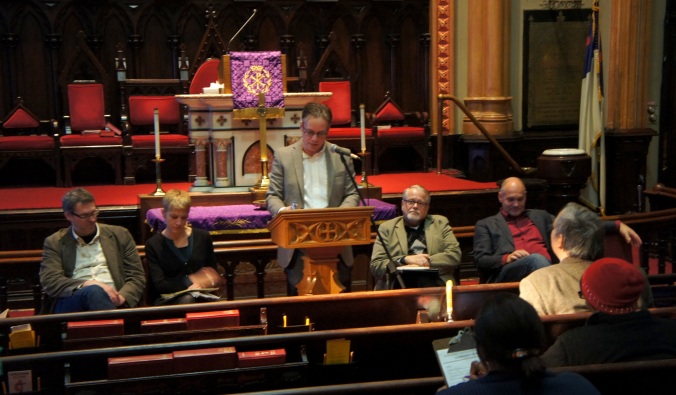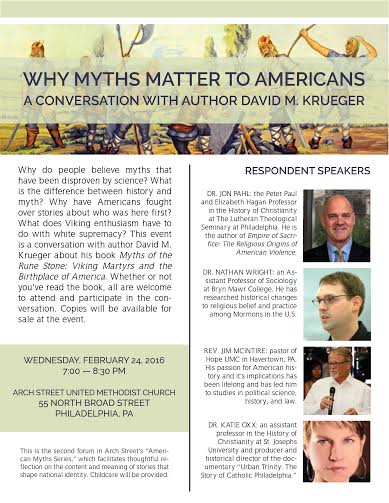
Uppsala University runic scholar Henrik Williams seated next to the Kensingon Rune Stone.
The aim of Myths of the Rune Stone: Viking Martyrs and the Birthplace of America is to tell the story of how the Kensington Rune Stone emerged as sacred, civic totem that embodied the aspirations and anxieties of Minnesotans in the twentieth century. Furthermore, it illuminates the various reasons that Minnesotans have wanted so badly to believe that Vikings visited the American Midwest long before Christopher Columbus reached the “New World.” The question of “is the rune stone real or fake?”is not the most important part of my analysis.
My working assumption has been that the runic inscrption unearthed in a Swedish immigrant’s farm field in 1898 was most likely created in the late nineteenth century. When people press me on the specifics of why I don’t consider it to be an artifact created in the fourteenth century, I refer them to the work of researchers who are better equipped to answer the geological, linguistic, archaeological, and historical questions pertinent to the Kensington Rune Stone. I remind people that I am primarily a 19th and 20th-century historian who specializes in social theory, religion, and American culture. Given the somewhat superficial attention I give to the question of the rune stone’s authenticity in my book, I have listed some additional resources here that will help readers to wrestle with the many scientific questions involved. Among the researchers I have found to be the most persuasive is runic scholar Henrik Williams.
Dr. Williams is a professor of Scandinavian languages at Uppsala University in Sweden and he is also the lead researcher for the American Association of Runic Studies, which is committed to historically accurate, peer-reviewed, scientific analysis of runes and runic inscriptions. The organization also coordinates academic exchanges between Sweden and the United States. In coming weeks, William will be traveling across the U.S. and may be speaking at a location near you (see full itinerary below).
I’m particularly excited that Dr. Williams will be speaking along with me at the Museum of Archaeology and Anthropology at the University of Pennsylvania in Philadelphia, PA on Monday, November 19 at 600 pm. The title of our panel is “Vikings, Pioneers, and Natives: the Kensington Rune Stone and the Contested History of the American Midwest.” Follow the links for the Penn Museum announcement and the Facebook event page. We will be joined by Dr. Ada Kuskowski (Department of History) and Dr. Brian Daniels (Penn Cultural Heritage Center) who are both professors at the University of Pennsylvania. The conversation will be interdisciplinary and will consider how ideas about race, religion, and science play out through the artifact known as the Kensington Rune Stone.
A light reception will follow the event and I’ll be there to sign books as well.
A complete list of the Henrik Williams events in the United States:
October 25, Seattle, WA
Norwegian Heritage Museum, Cracking the Runic Code
October 26, San Francisco, CA
6:00 p.m., Swedish American Hall at 2174 Market Street, San Francisco, CA
Runic Women
October 29, Northfield, MN
Norwegian American Historical Assn (NAHA) Annual Meeting, Saint Olaf College, (private event)
November 1, Saint Paul, MN
Minnesota History Center, Rune Stones American Style
November 3rd,, Alexandria, MN
Celebration Dinner, (private event)
November 5th, Bloomington, MN
Torske Klubben,“Cracking the Runic Code: Runes and Runic Inscriptions in Norway”, (members only event)
November 6th, Minneapolis, MN
Uppsala University Recognition: Minnesota Vikings vs. Detroit Football game
November 8th
Presentation/Discussion with UCO students Medieval Association. “Runes in Sweden and on Gotland” (class participation)
November 9th
“Forbidden Archaeology” with Dr. Andy White, University of South Carolina, Topic: Kensington Rune Stone, (class participation)
November 9th
Presentation/Discussion with UCO students, Historical Research Course, “Runes and North American Runes”, (class participation)
November 9th, Edmond, OK,
Oklahoma, Sons of Norway, (private event)
November 11, Sierra Vista, AZ
Windemere Conference Center, Henrik Williams: Runic Inscriptions in the Mustang Mountains
November 14, Philadelphia, PA
6:00 p.m., Rainey Auditorium, University of Pennsylvania Museum of Archaeology and Anthropology, 3620 South Street
November 17, Washington, DC
Smithsonian Associates, Henrik Williams: Cracking the Runic Code: The Alphabet of Mystery

 I wish I could say more more about my contribution to the upcoming show, but I have yet to see it myself! If you enjoy the segment of the Mysteries at the Museum episode, I encourage you to get a copy of my book,
I wish I could say more more about my contribution to the upcoming show, but I have yet to see it myself! If you enjoy the segment of the Mysteries at the Museum episode, I encourage you to get a copy of my book,  It was a pleasure to talk about Myths of the Rune Stone: Viking Martyrs and the Birthplace of America with Kristian Petersen from the New Books Network. I was able to share a bit about how I got interested in the scholarly study of history and religion. I also discussed the process of how I transformed my fairly voluminous dissertation (around 360 pages) into a slim and readable volume intended to reach a broad audience. This
It was a pleasure to talk about Myths of the Rune Stone: Viking Martyrs and the Birthplace of America with Kristian Petersen from the New Books Network. I was able to share a bit about how I got interested in the scholarly study of history and religion. I also discussed the process of how I transformed my fairly voluminous dissertation (around 360 pages) into a slim and readable volume intended to reach a broad audience. This 

 Welcome to the the website for
Welcome to the the website for 


